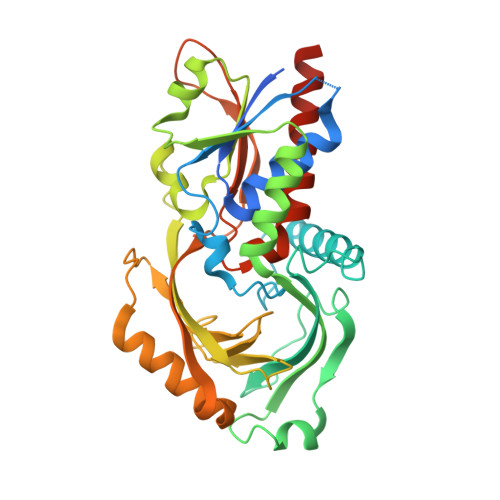Structural and mechanistic insights into ALS patient derived mutations in D-amino acid oxidase.
Khan, S., Upadhyay, S., Dave, U., Kumar, A., Gomes, J.(2023) Int J Biol Macromol 256: 128403-128403
- PubMed: 38035964
- DOI: https://doi.org/10.1016/j.ijbiomac.2023.128403
- Primary Citation of Related Structures:
8HY5 - PubMed Abstract:
The D-amino acid oxidase protein modulates neurotransmission by controlling the levels of D-serine, a co-agonist of N-methyl-D-aspartate receptors. Mutations in the DAO gene have been associated with ALS, with some studies reporting pathogenic mechanisms of the R199W mutation. We have characterized two novel mutations R38H and Q201R found in ALS patients and report certain novel findings related to the R199W mutation. We report the first instance of crystal structure analysis of a patient-derived mutant of DAO, R38H, solved at 2.10 Å. The structure revealed significant perturbations and altered binding with the cofactor (FAD) and the inhibitor benzoate, supported by biochemical assays. Q201R-DAO also exhibited significantly lower ligand binding efficiency. Furthermore, kinetic analysis across all variants revealed reduced oxidase activity and substrate binding. Notably, R38H-DAO exhibited near-WT activity only at high substrate concentrations, while R199W-DAO and Q201R-DAO displayed drastic activity reduction. Additionally, structural perturbations were inferred for R199W-DAO and Q201R-DAO, evident by the higher oligomeric state in the holoenzyme form. We also observed thermal instability in case of R199W-DAO mutant. We hypothesize that the mutant enzymes may be rendered non-functional in a cellular context, potentially leading to NMDAR-associated excitotoxicity. The study provides novel insights into structural and functional aspects of DAO mutations in ALS.
Organizational Affiliation:
Kusuma School of Biological Sciences, Indian Institute of Technology, New Delhi 110016, India; Indian Council of Medical Research, New Delhi 110029, India.


















